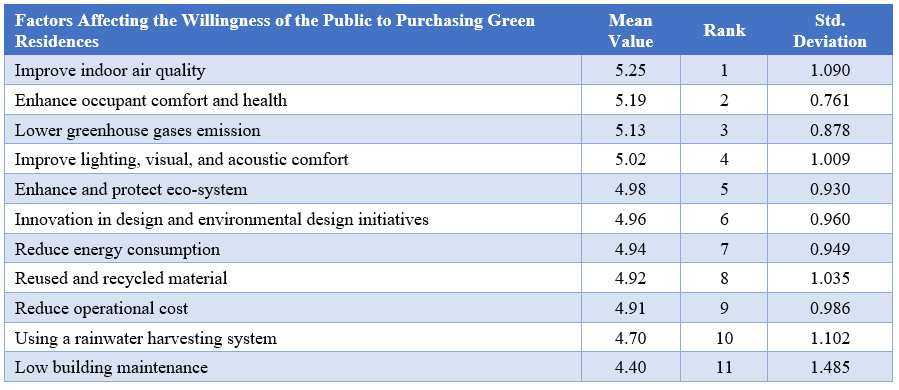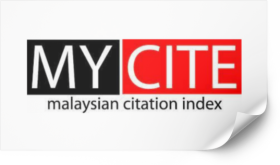Malaysia Green Residential Buildings and Factors Affecting the Willingness of Public on Buying Green Residential Buildings
DOI:
https://doi.org/10.37934/progee.25.1.3343Keywords:
Green Building Index, Sustainability, Public Willingness, FactorsAbstract
Green building has reduced the negative impact on natural environment which caused by construction activities. Commonly, these green building are built based on opinion and knowledge of construction players such as contractors, developer and engineer and their most critical point is to earn more return on investment, and the practicability and functionality of buildings. However, public is the consumer for green buildings, thus sometimes should listen to the voice out from public. In order to raise public demand for green building, this study is aimed to identify the factors affecting the willingness of public on buying green residential property. There is a rating system that Green Building Index (GBI) as a measurement standard to green building certification in Malaysia. A literature review was performed, followed by a questionnaire survey and a total of fifty-three valid responses are obtained through snowball sampling method. Apart from that, Cronbach’s alpha and mean score analysis were performed in this study. The results revealed that “improve indoor air quality”, “enhance occupant comfort and health” and “lower greenhouse gas emission” were the most important factors affecting public to buy the green residential property. The results of this study could contribute that young generation nowadays actually is most focus on own health and comfortable rather than cost since all the top three ranking is related with indoor environment quality. However, majority young generation respondent is also one of the limitations for this study.
References
N. Rashid, M.R. Shaharudin, Customer’s purchase intention for a green home, International Journal of Procurement Management 10 (2017) 581-599. https://doi.org/10.1504/IJPM.2017.086402.
M.N. RAZALI, M.Y. HAMID, Assessing green property management implementation among commercial buildings in Malaysia, WIT Transactions on Ecology and the Environment 226 (2017) 827-835. https://doi.org/10.2495/SDP170721.
B.A. Portnov, T. Trop, A. Svechkina, S. Ofek, S. Akron, A. Ghermandi, Factors affecting homebuyers' willingness to pay green building price premium: Evidence from a nationwide survey in Israel, Building and Environment 137 (2018) 280-291. https://doi.org/10.1016/j.buildenv.2018.04.014.
J.S. Khan, R. Zakaria, S.M. Shamsudin, N.I.A. Abidin, S.R. Sahamir, D.N. Abbas, E. Aminudin, Evolution to emergence of green buildings: A review, Administrative Sciences 9(1) (2019) 6. https://doi.org/10.3390/admsci9010006.
E.K. Simpeh, J.J. Smallwood, Analysis of the benefits of green building in South Africa, Journal of Construction Project Management and Innovation 8(2) (2018) 1829-1851. https://doi.org/10.36615/jcpmi.v8i2.161.
A. Darko, A.P. Chan, Review of barriers to green building adoption, Sustainable Development 25(3) (2017) 167-179. https://doi.org/10.1002/sd.1651.
K. Fan, E.C. Hui, Evolutionary game theory analysis for understanding the decision-making mechanisms of governments and developers on green building incentives, Building and Environment 179 (2020) 106972. https://doi.org/10.1016/j.buildenv.2020.106972.
Y. Li, M. Li, P. Sang, P.-H. Chen, C. Li, Stakeholder studies of green buildings: A literature review, Journal of Building Engineering 54 (2022) 104667. https://doi.org/10.1016/j.jobe.2022.104667.
L.N. Dwaikat, K.N. Ali, Green buildings cost premium: A review of empirical evidence, Energy and Buildings 110 (2016) 396-403. https://doi.org/10.1016/j.enbuild.2015.11.021.
H.S. Abdulaali, M.M. Hanafiah, I.M. Usman, N.U.M. Nizam, M.J. Abdulhasan, A review on green hotel rating tools, indoor environmental quality (IEQ) and human comfort, International Journal of Advanced Science and Technology 29 (2020) 128-157.
M. Shan, B.-g. Hwang, Green building rating systems: Global reviews of practices and research efforts, Sustainable cities and society 39 (2018) 172-180. https://doi.org/10.1016/j.scs.2018.02.034.
S.N. Kamaruzzaman, E.C.W. Lou, N. Zainon, N.S.M. Zaid, P.F. Wong, Environmental assessment schemes for non-domestic building refurbishment in the Malaysian context, Ecological Indicators 69 (2016) 548-558. https://doi.org/10.1016/j.ecolind.2016.04.031.
N.M. Abd Rahman, C.H. Lim, A. Fazlizan, Optimizing the energy saving potential of public hospital through a systematic approach for green building certification in Malaysia, Journal of Building Engineering 43 (2021) 103088. https://doi.org/10.1016/j.jobe.2021.103088.
S. Pandey, Impact of green building rating systems on the sustainability and efficacy of green buildings: case analysis of green building index, Malaysia, Malaysia Sustainable Cities Program, Working Paper Series [(accessed on 24 August 2019)] (2018).
G.B. Index, GBI assessment criteria–for residential new construction, 2013.
M. Marhani, M. Muksain, GBI assessment checklist: Level of awareness of the contractors in the Malaysian construction industry, IOP Conference Series: Earth and Environmental Science, IOP Publishing, 2018, pp. 012024. https://doi.org/10.1088/1755-1315/117/1/012024.
C.Q. Li, Interpreting ASHRAE 62.1: ASHRAE Standard 62.1 is best known for its regulation of the amount of ventilation air delivered to each space in a commercial building by HVAC systems through various ventilation approaches to system design, Consulting Specifying Engineer 56 (2019) 35-43.
N. Nizarudin, M. Hussain, I. Tukiman, The application of the Green Building Index (GBI) on sustainable site planning and management for residential new construction: prospects and future benefits, Sustainable Tropical Environmental Design Conference 2010 (SUSTED 2010), 2010.
S.M. Algburi, A. Faieza, B. Baharudin, Review of green building index in Malaysia; existing work and challenges, International Journal of Applied Engineering Research 11 (2016) 3160-3167.
A. Ahuja, Integrated M/E Design: Building Systems Engineering, Springer Science & Business Media, 2013.
B. Manzoor, I. Othman, S.S. Gardezi, E. Harirchian, Strategies for Adopting Building Information Modeling (BIM) in Sustainable Building Projects—A Case of Malaysia, Buildings 11 (2021) 249. https://doi.org/10.3390/buildings11060249.
N. Shabrin, S.B.A. Kashem, A comprehensive cost benefit analysis of green building, in: Proceedings of 94th The IIER International Conference, 2017.
W.-L. Tan, Y.-N. Goh, The role of psychological factors in influencing consumer purchase intention towards green residential building, International Journal of Housing Markets and Analysis 11(5) (2018) 788-807. https://doi.org/10.1108/IJHMA-11-2017-0097.
P. Sang, H. Yao, L. Zhang, S. Wang, Y. Wang, J. Liu, Influencing factors of consumers’ willingness to purchase green housing: A survey from Shandong Province, China, Environment, Development and Sustainability 22 (2020) 4267-4287. https://doi.org/10.1007/s10668-019-00383-8.
S. Ofek, S. Akron, B.A. Portnov, Stimulating green construction by influencing the decision-making of main players, Sustainable cities and society 40 (2018) 165-173. https://doi.org/10.1016/j.scs.2018.04.005.
Q. He, H. Zhao, L. Shen, L. Dong, Y. Cheng, K. Xu, Factors influencing residents’ intention toward green retrofitting of existing residential buildings, Sustainability 11(5) (2019) 4246. https://doi.org/10.3390/su11154246.
M.O. Oyewole, A.A. Ojutalayo, F.M. Araloyin, Developers’ willingness to invest in green features in Abuja, Nigeria, Smart and Sustainable Built Environment 8(3) (2019) 206-219. https://doi.org/10.1108/SASBE-06-2018-0031.
I.M.C.S. Illankoon, W. Lu, Cost implications of obtaining construction waste management-related credits in green building, Waste Management 102 (2020) 722-731. https://doi.org/10.1016/j.wasman.2019.11.024.

Downloads
Published
How to Cite
Issue
Section
License
Copyright (c) 2023 Progress in Energy and Environment

This work is licensed under a Creative Commons Attribution-NonCommercial 4.0 International License.











